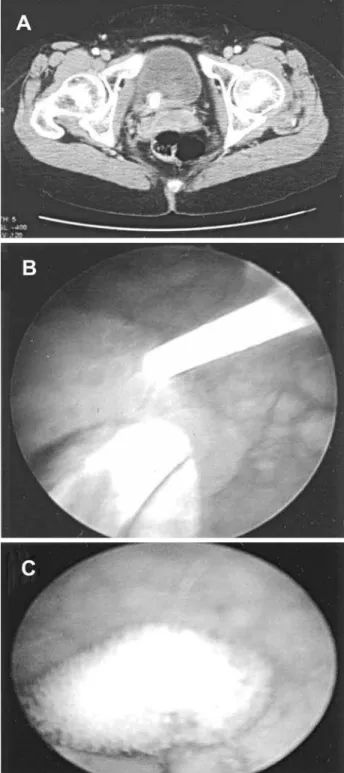549
URETEROCELE PRESENTING AS BLADDER TUMOR Case Report
International Braz J Urol
Official Journal of the Brazilian Society of Urology
Vol. 31 (6): 549-551, November - December, 2005
ORTHOTOPIC URETEROCELE MASQUERADING AS A BLADDER
TUMOR IN A WOMAN WITH PELVIC PAIN
DAVID D. THIEL, STEVEN P. PETROU, GREGORY A. BRODERICK
Department of Urology, Mayo Clinic Jacksonville, Jacksonville, Florida, USA
ABSTRACT
Single system orthotopic ureteroceles often present in adulthood are associated with charac-teristic radiographic findings. We present the case of a 54 year old woman with 8 months of urgency/ frequency and pelvic pain that has the cystoscopic appearance of a bladder tumor. Cystoscopic im-ages, radiographs and intraoperative photos demonstrate the work-up, evaluation, and treatment of this unique single system orthotopic ureterocele containing a calculus. This patient demonstrates the need for cystoscopy accompanied by upper tract imaging in patients with new onset pelvic pain, urgency/frequency, and frequent urinary tract infections.
Key words: bladder; ureterocele; bladder neoplasms; ureteral calculi; pelvic pain
Int Braz J Urol. 2005; 31: 549-51
CASE REPORT
A 54 year old white female was referred from her gynecologist for a bladder tumor. The patient had complained of worsening lower abdominal and pel-vic pain accompanied by urinary urgency/frequency for the past 8 months. Treatment of four separate cul-ture proven E. coli urinary tract infections with ap-propriate antibiotics failed to relieve the patient’s symptoms. Diagnostic cystoscopy was performed to evaluate the complaints and the patient sent to urolo-gist for the finding of a bladder tumor.
Past medical history was significant for os-teoporosis and carpal tunnel repair. The patient was a hair dresser with a 30 pack-year smoking history. The patient denied any previous urologic history includ-ing calculi or hematuria. Physical exam revealed a physically fit female without costo-vertebral tender-ness. Laboratory evaluation revealed only micro-scopic hematuria with negative urine cytology.
In office cystoscopy was performed that re-vealed a papillary bladder tumor present at the right
lower posterior portion of the bladder (Figure-1). The right ureteral orifice could not be identified. An ex-cretory urogram was performed that revealed a non-obstructing, single system, distal right ureteral calcu-lus surrounded by a radiolucent ring (Figure-1). Pel-vic CT scan demonstrated what appeared to be a stone contained in a distal right ureterocele (Figure-2).
The patient was taken to the operating room and cystoscopy performed. One ampoule of intrave-nous indigo carmine solution was given that eventu-ally was secreted from the ureteral orifices. Once the opening of the right ureteral orifice was identified via secretion of the blue dye, a 5F open-ended cath-eter was placed inside the orifice into the kidney un-der fluoroscopic vision (Figure-2). The orifice was then sliced open utilizing endoscopic shears expos-ing a large stone (Figure-2). The stone was removed from the bladder and the ureteral stent removed.
550
URETEROCELE PRESENTING AS BLADDER TUMOR
voiding cystourethrogram performed at the 6 month postoperative visit failed to demonstrate vesico-ure-teral reflux.
COMMENTS
Single system (orthotopic) ureteroceles are usually discovered in adults and are almost always intravesical (1). Urinary stasis in the dilated distal segment often lends to urinary infection and stone formation; precluding the most common presenting symptoms of dysuria, urgency, and recurrent urinary infections.
Figure 1 – A) Cystoscopic view of possible bladder tumor. Bullous edema surrounding ureterocele mimics bladder tumor. Note that the right ureteral orifice cannot be visualized. B) Excretory uro-gram with characteristic “cobra head” sign. Contrast medium pools in the distal dilated portion of the ureterocele. The sur-rounding halo is formed from a filling defect representing ure-terocele wall.
551
URETEROCELE PRESENTING AS BLADDER TUMOR
Diagnosis is often via excretory urography demonstration of the characteristic “cobra-head” sign (Figure-1). The radiolucent halo surrounding the dense filling area is a filling defect representing the ureterocele wall (1).
Intravesical incision of the ureterocele is the treatment of choice in adults and has been described utilizing endoscopic shears and holmium laser tech-nology (2). Vesico-ureter reflux is seldom a problem following incision (3).
This patient demonstrates the necessity of cystoscopy accompanied by upper tract imaging in patients presenting with new onset urinary urgency/ frequency or pelvic discomfort. The bullous edema surrounding an intravesical ureterocele containing calculus such as this case can mimic bladder tumors and confuse the less experienced cystoscopist.
CONFLICT OF INTEREST
None declared.
REFERENCES
1. Schlussel RN, Retik AB: Ectopic Ureter, Ureterocele, and other Anomalies of the Ureter. In: Walsh PC et al. (eds.), Campbell’s Urology, Philadelphia, WB Saunders. 2002; 8th ed., pp. 2022-34.
2. Aron M, Costello AJ: Case report: holmium laser re-section and lasertripsy for intravesical ureterocele with calculus. Lasers Surg Med. 2001; 29: 82-4.
3. Rich MA, Keating MA, Snyder HM 3rd, Duckett JW: Low transurethral incision of single system intravesi-cal ureteroceles in children. J Urol. 1990; 144: 120-1.
Received: May 12, 2005 Accepted after revision: July 25, 2005
Correspondence address:
Dr. David D. Thiel
3 East Urology - Davis Building Mayo Clinic Jacksonville 4500 San Pablo Road
Jacksonville, Florida, 32224, USA Fax: + 1 904-953-7330
